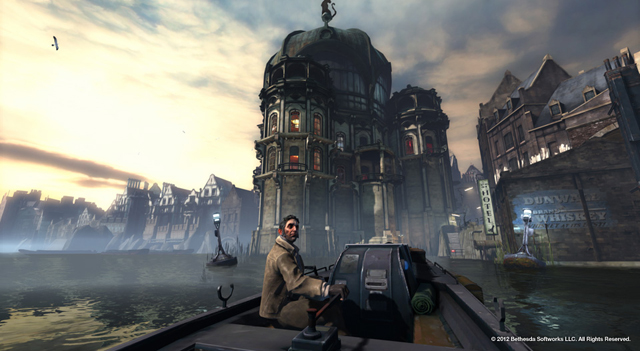Five years ago, launching a decent streaming platform took millions. Now? A teenager with a laptop can build something that reaches millions. That shift…
Dishonored review: executed to perfection

Designing Perfection
There was something special about the first time you played Half-Life. You were immersed into the world of Black Mesa and you really felt as though you were Gordon Freeman, a crowbar-wielding engineer, and not just some guy with a gun. Or what about the first time you loaded up BioShock and Rapture came alive before your very eyes. These games were unlike their contemporaries in that they created an atmosphere that was unique and memorable. No game has come close to capturing that same experience until now.
Sure last year’s Deus Ex had player choice and great powers to play with, but the level design clearly laid out a ‘sneaking path’, ‘combat path’ and ‘hacking path’ which broke the immersion, and don’t even get me started on those boss battles. And yes Skyrim had an engrossing world that you could get lost in, but the movement and combat mechanics were found wanting.
Dishonored though, hits the mark in all departments. The world is distinct and controlling its hero Corvo is an absolute treat. It might not be quite as unique as its predecessors because it borrows from its influences, but boy is it memorable.
Blink and you miss it
What makes controlling Corvo so unforgettable is the power ‘Blink’ — a thing of gaming beauty. The designers want you to use Blink, and so they give it to you early on in the game for free. This short distance teleportation is the portal or gravity gun of Dunwall. Blink is essential to success in Dishonored, regardless of whether you choose a stealth or combat-based approach to the game.
Simply aim at your desired spot — whether your goal is to climb vertically, dash horizontally, escape, attack, skulk, explore — Blink is your tool, and a dastardly fun one at that (just make sure to upgrade for added zing). Corvo controls a lot like Faith in Mirror’s Edge, you’ll see his feet as he slides and his hands break high falls. He can sneak, run, jump (double jump with an upgrade), but all at the centre of it is Blink.
Other powers have to be purchased using runes that are scattered throughout the levels or obtained doing morally sound (or grey) deeds. The skill tree is not that in-depth, the designers actually want you to use all the powers in the game rather than experiment with and discard dozens of options. And so there are six active powers: Dark Vision, Blink, Time-Bend, Possession, Devouring Swarm and Windblast.
Each skill has various applications in stealth or combat, but the manner in which you combine your powers is where the real fun begins. This video gives an idea of some combinations:
There are four passive skills: Vitality, Blood Thirsty, Agility and Shadow Kill. In order they improve your health, use adrenaline to pull off brutal attacks, increase jump height and movement speed and lastly turn enemies into ash. There aren’t enough runes in one playthrough to unlock all of the powers and their upgrades, and so everyone’s Dishonored experience will be different. Bone charms serve as the last of the supernatural abilities — these perks can be collected on each stage and give extra passive enhancements such as extra life, chance to dodge and so on.
There are weapons and gadgets at Corvo’s disposal too: crossbows, pistols, grenades and traps help form your arsenal and all can upgraded for money. However, Corvo always has his assassin’s blade in his right hand. This is perhaps the only design choice I don’t agree with – for example you cannot have a power in one hand and a crossbow in the other, you always have your blade in your right hand and have to alternate powers and other weapons in your left. A minor niggle, but perhaps this could have opened up even more variety in the ways to play the game.
The UI is simple, it’s a clean interface with small health and mana bars at the top left of the screen, a small icon indicates which power is selected and another whether you are crouched — the rest is the world of Dunwall. If you need extra information a journal can be accessed at the press of a button.
One genius UI choice is The Heart. Corvo holds this mechanical organ as he would a power or weapon. When equipped it shows hotspots on your screen including objectives, target distances, optional quests, runes and bone charms. It beats faster as you near a hotspot, and even stylishly tells you peoples’ secrets if you right-click on them – giving personality to a game mechanic.
AI is not just a movie starring Jude Law
The enemy AI reacts well in stealth scenarios. If they think they see something or hear you nearby an alerted marker turns grey above their head — at this alert mode they search around for you. However if you hide or run away they’ll quickly forget what they were doing and go back to their regular patrols.
However if they see you outright or you attack them their alert marker turns red – at this level they will call for help or sound alarms all the while running at you to try and kill you. They’re not the smartest henchmen, but who said that the protectors of Dunwall’s elite would have high IQs?
Later on henchmen do get a lot tougher, they will dodge your sword swipes, attack in droves and some can prevent you from using powers in their vicinity. Tallboys, the only enemy with heavy-duty mechanical aid, prove a particularly tough challenge in a fight. My recommendation: use the sewers.
The game can be really tough at times. Although Corvo has magical powers, he is quite vulnerable and can die from just a few hits. You will die often, and so quicksave to your heart’s content because the autosave feature isn’t going to do you any favours.
Boxes made of sand
The level design deserves awards in its own right. Each level is a self-enclosed sandbox, and they are all huge. There are multiple routes to achieve the same objective and the game rewards exploration with bonus money, back story, interesting side characters and so on. It’s all in the little details.
There are only nine levels, but with optional quests galore and several ways to eliminate your target(s) a thorough exploration of the game will see it clock in at around 12-15 hours. But with numerous choices you’ll want to play the game a second, if not third, time.
Each level offers a non-lethal option to complete the main objective, and the game asks you to make moral choices that are surprisingly interesting and complex. Do you save one character over another, kill both or neither? Each decision results in story and item rewards (or punishments) and all inform which of the two endings you get.
Mr. Nigglesworth
The plot is the poorest part of Dishonored — not because it’s awful but because it is the one element that is not wholly original. Its well-worn clichés stand out because everything else is so fresh and exhilarating. This is not enough to detract from the Dishonored experience though, and despite a by-the-numbers plot, the characters are memorable. This is mainly due to the star-studded cast that gives Dishonored the best ensemble in gaming history — Susan Sarandon as the creepy Granny Rags is my standout performance.
Graphically, Arkane Studios have done wonders with the Unreal Engine 3, the textures are great and body animations are fantastic, despite some so-so facial animations. The music, composed by Daniel Licht (Dexter score), fits the tone of Dunwall flawlessly.
Some people might complain about Dishonored: they might say there is no multiplayer, that stealth is favoured over combat and that your choices are not as open as the designers led on. However there is not one design-choice in Dishonored that feels out-of-place and they all result in the most memorable single-player game in years.
I can’t fault Dishonored for anything other than a couple of niggles and it’s plot. But it would be ridiculous to berate it for those reasons because everything else is just so brilliant. I give the best game of the year a slap on the wrists simply in the name of objectivity and then I slap myself for doing so… because Dishonored is a gaming masterpiece.
Version Tested: PC
Also available on: Xbox 360, PS3




